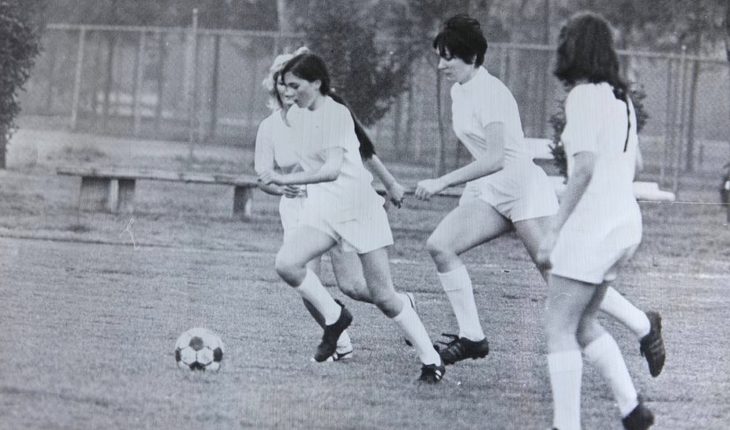it lasted little… but for three memorable weeks in the summer of 1971, women’s football broke out with the brightness of a Comet, before crashing into the Earth.
Barely 14 months after Brazil crush Italy at the male end of the 1970 World Cup, in city of Mexico, the football fever again swept the host nation, but this time by a non-official world of women.
And not only fans were caught up in the excitement: great brands, broadcasters and retailers of all types also wanted to participate, since women’s soccer became briefly in a commercial product at the same time male game.
Now, you just make the draw for the women’s World Cup 2019, the tournament is big business, and has the backing of 11 major brands. But this commercial approach was a novelty in 1971.
“A different world” “was like entering the Tardis (Doctor Who series time machine) or travel to Narnia: was transported to a different world”, recalls the excentrocampista of the English selection Chris Lockwood, who at the time was 15 years and now has 62.
“I don’t think we knew what to expect. Only we had played in the small qualifying tournament in Sicily, which was played on courts such as those that are in the parks, as we were accustomed”.
“And, suddenly, we were in the middle of the World Cup fever in this enormous and dazzling tournament professional and global”.
The tournament, which featured six teams, was sponsored by the Italian giant Martini & Rossi beverages, and other sponsors included the beer brand Mexican Carta Blanca, refreshment slimming Dietafiel and the local brand of tea Lagg completo.
A large amount of alcohol, electronic products and others were sold around the Azteca Stadium in Mexico City.
Logos, t-shirts, bags, dolls, magazines and programs were manufactured to sell, and many of the articles showed the tournament mascot: Xochitl, a young footballer dressed in the colors of Mexico.
Meanwhile, the sales of tickets – with a price that ranged from 30 pesos (US$ 1.45) to 80 (US$ 3.80) – exceeded expectations, and the largest crowd to attend a women’s football match was recorded in this tournament.
Approximately 110,000 fans attended the final, between Mexico and Denmark, while about 80,000 saw Mexico vs England.
Taking advantage of Mexico ‘ 70 current so that the event was attractive for a female audience and family, the posts of the stadium were decorated pink, and the tournament staff, including translators of the teams, dressed in pink costumes distinctive.
Professor Jean Williams leading the academic “hidden women’s soccer stories” project at the National Museum of football in England.
“Mexico ‘ 71 was a success because the organizers not assumed that it would be a commercial or sporting failure. It was sold and promoted as a tournament of football, one that is coincidentally starring women”, it has.
“They also assumed that there would be large crowds in two stages, which had been used in the male World Cup the previous year.”
Williams says that the key to commercial success was the use of the mascot Xochitl, and the hiring of a powerful public relations team to get television coverage and press.
“Ridiculous” in 1971, the British media compared to the young star of England, the midfielder of 13 Leah Caleb, with George Best of Manchester United, as the team prepared to travel to Mexico.
Caleb, now 60 years old and recently retired after a career in the national system of health, recalls: “participating in the event gave a blow to the FA (acronym in English of the English Football Association).” It banned us play (locally) for participating in a World Cup that was not official”.
“But they quickly realized that they were being ridiculous and the prohibitions were lifted.”
In fact, it could be argued that the participation of the team played an important role in the decision of the FA finally lift, that same year, his broader, 50 years ban, banning women’s soccer.
The visionary the rigid approach of the FA contrasted with the vision of future of the figure behind the team of England in 1971, Harry Batt, Secretary of the women’s club of Chiltern Valley, from whence came most of the selected English.
He is intriguing, Batt worked in a factory in Luton and could speak several languages. He was convinced that women’s soccer would be commercial and players would be professional.
“I am sure that in the future there will be full time professional ladies teams in this country, and we expect to be one of the first,” he said in 1971.
He believed that England could emulate to Italy, where he had led a team in 1970 for the first unofficial World Cup of women, and women played before crowds of 30,000 people.
But, like the World Cup in 1971 itself, it would be a couple of decades ahead of its time.
It suffered to be excluded by the FA, and the team of his club, who was trained by his spouse, June, withdrew.
Those who paid for all sponsors of the women’s world of Mexico, Martini & Rossi, the event was an opportunity to take advantage of the publicity that already had been placed in the Stadium during the men’s World Cup, the previous year.
Italian drinks giant paid the expenses of each of the teams of 1971, including flights, hotels and clothing.
“It was an opportunity to make them promote your brand,” says Gill Sayell, player from England, who is now 62 years old and then had 14.
“They also provided great Gold Cup teams disputed, which paid for the England team stayed one week more since we eliminated.”
Lockwood, Caleb, Sayell and her teammates did not receive any payment, official or unofficial, for his efforts in Mexico, while they received a reception at the British Embassy.
Exjugadores BBCLas of England Chris Lockwood (left), Leah Caleb and Gill Sayell recall Mexico 1971.” Brutal”match against Argentina unfortunately for England, lost their three matches, 4-1 against Argentina, Mexico 4-0 and 3-2 against France.
In the final, Denmark defeated host nation, adding another victory of the previous year in the World Cup unofficial of 1970.
“Our match against Argentina was brutal and two English players ended up having to use casts,” recalls Caleb.
“But we have not changed our experience for anything. In addition to the opportunity to play on the same field that Pelé, Mexicans – many of whom had very little – welcomed us really”.
Now you can receive notifications of BBC world. Download the new version of our app and activate them so you don’t miss our best content.
https://www.youtube.com/watch?v=ElxR2is1_bk https://www.youtube.com/watch?v=K5Yw1fdnWXc
translated from Spanish: The little known story of the world 1971 Mexico
December 10, 2018 |





